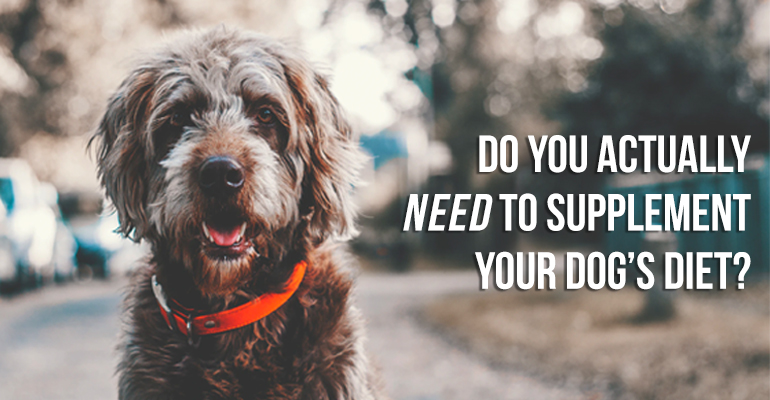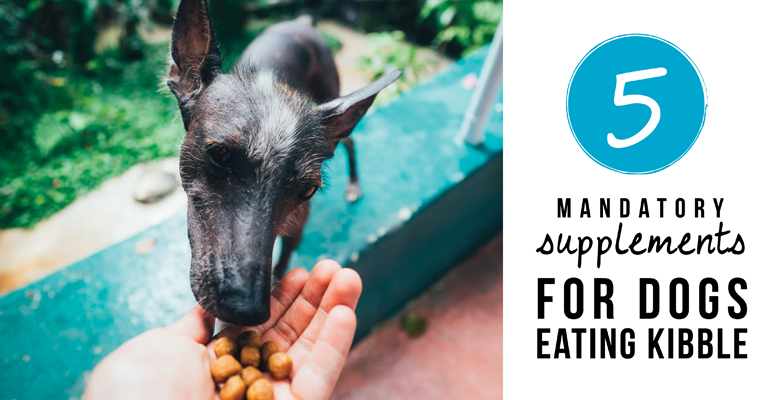
Shelly scoops two perfectly leveled cups of dry yet overpoweringly pungent kibble. She lovingly drops them into the sea foam ceramic bowl adorned with paw prints.
She scoops, pours, and repeats morning and night, day after day for her senior pup, Diego.
Diego’s been on the food forever. He’s slowed down, has a few more aches and pains, but he still seems perfectly content each time the bowl is placed at his feet. So, Shelly doesn’t think twice about feeding him something else or adding anything to his bowl.
Rodger opts for the grain-free kibble because his dog Marsha has a food sensitivity.
To put it politely, it’s been a journey finding a food that works for her and he wouldn’t dare add, subtract, or otherwise touch the kibble she’s on right now other than scooping it into her bowl.
Their circumstances may be different but both Rodger and Shelly stick to their kibble because it works.
Neither feeds anything but and they don’t really question whether they should add anything because each of their brands of dog food says “complete & balanced” for dogs right front and center on the bags. It’s dog food pure and simple.
But what exactly are dogs getting in a “Complete & Balanced” dog food?
Per AAFCO, the Association of American Feed Control Officials:
“Complete” means the product contains all the nutrients required.
“Balanced” means the nutrients are present in the correct ratios.
Basically, as a pet parent you’re guaranteed that the macronutrients along with the micronutrients are addressed.
MACRONUTRIENTS
PROTEIN
FAT
FIBER
MOISTURE
FATTY ACIDS
MICRONUTRIENTS
VITAMINS
MINERALS
The statement implies that that pet food can support an animal’s health and wellness.
Standards like these are in place for a reason. Any food on the shelf has to have some sort of accountability and these standards ensure that x, y and z are met to protect our dogs (and thank dog for it!).
But we also need to be aware that the standard has its own set of limitations.
Complete and balanced only means that it has an adequate amount of macro and micronutrients to sustain life.
Put simply, the standard means your dog will, at the very least, live if fed that food.
Despite the fact that the standard is solely about adequacy it seems to have propagated the belief that if pets are fed two scoops of “Complete & Balanced” kibble, twice a day every day for life, there’s no need to add any other ingredient to their diets– not whole foods or phytonutrients, certainly not herbs.
GAPS IN THE DIET
So, we know what a bag of kibble gives our dogs:
macronutrients– fat, protein, and carbs *
micronutrients– vitamins and minerals
*water is a macronutrient but there’s certainly not enough in a bag of kibble alone
But what aren’t they getting from it? Other than macro and micronutrients, what would an animal get from their prey? (Ya know, what they subsisted on long before kibble was even a thought…) Well, a whole heck of a lot actually.

Glucosamine, chondroitin, & hyaluronic acid
In the wild, when a dog devours his prey, he’d eat the joint capsule, joint fluid, and the cartilage caps of the bones.
This would nourish his joints providing them the building blocks needed for joint health: glucosamine, hyaluronic acid, and chondroitin. (Diego could really benefit from this…)
Alpha lipoic acid
This brain-supporting nutrient is found in red meat, and in particular, organ meat.
A dog would eat nutrient-rich organ meats first getting a nice boost of antioxidants which would then be converted into glutathione; the body’s most important antioxidant.
Probiotics
In the wild, dogs would hunt prey, they’d eat the leftovers from every animal that was killed, and those that had just died. (Gross, but they’re not ones to discriminate.)
And that raw meat isn’t sterile; it carries bacteria including the healthy, beneficial kind that are crucial to a good gut biome.
These good bacteria are live microorganisms that flood the gut and fend off bad bacteria that take up residence there. That’s why beneficial bacteria like probiotics make such a good addition to every dog’s diet. (Marsha could certainly use a probiotic or 10 billion…)
Antioxidants
Antioxidants can come from either what we produce in our own bodies or what we consume in our diets.
As we age, our own endogenous antioxidant levels (the ones our rather miraculous bodies produce) start to decrease.
If we don’t increase our dietary antioxidant levels, then our bodies are open to damage from free radicals and oxidative stress which can lead to a host of health issues.
Dietary antioxidants are obviously that much more crucial as animals age.
And as it turns out, they have been surprisingly good at getting them on their own.
As a part of their naturally carnivorous diet, a dog would consume their entire prey, ingesta and all.
The animals they consume are typically herbivores, eating greens, nuts, seeds, berries, and root vegetables that are rich in antioxidants.
As scavenger carnivores, dogs would also search out rotting fruits, eat grasses and herbs, and dig up vegetables. That rather indiscriminatory behavior provides them with excellent sources of proteins, essential-fatty acids, vitamins and minerals, as well as antioxidants.
Glucosamine, probiotics, antioxidants– these are just some of the beneficial nutrients a dog would get from prey.
They’re all necessary to support health and wellness in dogs but you won’t find adequate *wink* amounts of any of those nutrients in a bag of kibble. That’s largely because they aren’t recognized as essential nutrients as far as “Complete & Balanced” standards are concerned.
But again, that’s because “Complete & Balanced” statement is a blanket standard focused on adequacy.
While that’s a good beginning, that’s all it is; a start.
HOW SUPPLEMENTATION HELPS
Before we talk about the chicken, we have to discuss the egg.
Food lays the foundation of health so ideally before even thinking about supplements, we want to improve every dog’s diet.
Remember, as scavenger carnivores, dogs would get all the nutrients they needed to nourish their joints, to provide antioxidants, to support their gut health, and so on, simply by eating real foods. Our dogs are no different.
Dogs eating real, whole foods are more vibrant, have healthier skin and shinier coats, clean teeth, a stronger immune system, and healthier body weight. Dogs have been thriving on real, whole foods much longer than they’ve been surviving on kibble so if we raise their plane of nutrition, making sure to feed real, whole foods, there aren’t as many gaps to fill in.
Even consider feeding 50/50 and mixing in a freeze-dried raw food for dogs because just doing that will make a substantial impact on their health.
If you do feed kibble just know that supplementation can help fill in the gaps where processed, shelf-stable food falls short.
PRO TIP
Not all supplements are created equal and that includes pet foods that advertise added benefits. If it says it contains omegas or probiotics you should approach it with the same scrutiny that you would any supplement.
Are there therapeutic levels of active ingredients?
Where are these ingredients sourced from and is their efficacy proven?
How does the manufacturing process (think extrusion and hot temperatures) affect the availability of some of the heat-liable nutrients in that food?
Because again, knowing that a dog would get x, y, and z from its naturally carnivorous diet and it’s not being met in heavily processed, shelf-stable kibble, supplementation really just makes sense. It could be adding glucosamine and chondroitin, phytonutrients, probiotics or herbs– every addition to their diet will benefit your dog’s health and wellness.
If you’re at a loss on how or where to start every kibble-fed dog can benefit from these five supplements.
So… get to supplementing already!




